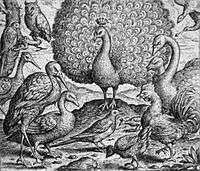Marcus Gheeraerts the Elder
Marcus Gheeraerts the Elder (c. 1520 – c. 1590) was a Flemish printmaker and painter associated with the English court of the mid-16th century and mainly remembered as the illustrator of the 1567 edition of Aesop's Fables.
Biography
Born in Bruges, Flanders, Gheeraerts fled to England in 1568 with his son, Marcus Gheeraerts the Younger (1562–1635), due to the Alvan religious persecutions. There he married his second wife, Sussanah de Critz, a close relative of Queen Elizabeth I's serjeant-painter, John de Critz. He was in London for at least 9 years but may have returned to Flanders around 1577 to continue his career in Antwerp. However, Gheeraerts retained links with England: he had his son enrolled in the painters guild and one of his daughters, Sarah, married the famous French-born English limner Isaac Oliver.
Gheeraerts is most noteworthy as a printmaker. He was a keen innovator and experimented with etching at a time when woodcut and engraving were dominant techniques. For example, his 1562 birds-eye view of the town of Bruges was etched on no fewer than 10 different plates, and the resulting map measures 1m x 1.8m.
Gheeraerts' style resembles that of Pieter Bruegel the Elder. In his own day, Gheeraerts was particularly famous as a draughtsman of birds and animals, and since the Protestant Reformation had caused a still-stand in the church art market, he showcased his talent in the fable book De warachtighe fabulen der dieren from 1567.[2] He etched the title page and 107 fable illustrations and had his friend, Edewaerd de Dene, write the book's fables in Flemish verse. Gheeraerts based most of his motifs on woodcuts by Virgil Solis and Bernard Salomon but gave his subjects greater naturalism. Gheeraerts added another 18 illustrations and a new title page for a French version of the Fabulen that was published in 1578 under the title Esbatement moral des animaux.[3] A Latin version, Mythologia ethica, was published in the following year with a title page likely based on a drawing by Gheeraerts. The copper plates were used in books well into the 18th Century and the fable series was copied by artists all over Europe. Gheeraerts also etched a second series of 65 illustrations for the fable book Apologi creaturarum, which was published in Antwerp in 1584. However, the etchings were smaller than those of the first series and never achieved the same popularity.
Less is known about Gheeraerts' color portraits or paintings as he never signed his work, and what does exist is identifiable only from stylistic considerations – a certain "fuzziness" and an attempt to imitate Flemish artists of the past such as Jan van Eyck. Karel van Mander wrote in his Schilderboeck from 1604 that Gheeraerts was a good landscape painter, who "often had the habit of including a squatting, urinating woman on a bridge or elsewhere."[2] A similar detail is seen in one of his fable illustrations.
Notes
- ↑ The etching is also known as Allegory of Iconoclasm. Although not particularly sympathetic to the Calvinist image breakers, it is mainly critical of the Church. Thus the etching might have been the main reason why Gheeraerts had to flee to England in 1568. (British Museum, Dept. of Print and Drawings, 1933.1.1..3, see also Edward Hodnett: Marcus Gheeraerts the Elder, Utrecht 1971, pp. 26-7)
- 1 2 Marcus Geerarts biography in Schilder-boeck (1604) by Karel van Mander, courtesy of the Digital library for Dutch literature
- ↑ http://britishlibrary.typepad.co.uk/european/2015/10/the-esbatement-moral-des-animaux.html
References
- Main treatise
- Edward Hodnett: Marcus Gheeraerts the Elder of Bruges, London, and Antwerp, Utrecht (Haentjens Dekker & Gumbert) 1971.
- General references
- William B. Ashworth: Marcus Gheeraerts and the Aesopic connection in seventeenth-century scientific illustration, Art Journal', 44 (1984), 132–138.
- Alastair Duke: Chapter Calvinists and 'papist idolatry': the mentality of the image-breakers in 1566 in Dissident Identities in the Early Modern Low Countries, Ashgate Publishing Limited, 2009 (Page 196 shows a list of items shown in Gheeraerts' etching referring to the letter indices placed by Gheeraerts into the etching.)
- Mikael Lytzau Forup: 125 fabler med illustrationer af Marcus Gheeraerts den Ældre [Danish: 125 fables with illustrations by Marcus Gheeraerts the Elder], Odense (University Press of Southern Denmark) 2007. (The book features Gheeraerts' entire Aesop series of 125 fable illustrations and 3 title pages.)
- Reginald Lane Poole (Mrs.): Marcus Gheeraerts, Father and Son, Painters, The Walpole Society, 3 (1914), 1-8.
- Arthur Ewart Popham: The etchings of Marcus Gheeraerts the Elder, Print Collector's Quarterly, 15 (1928), 187-200.
- Eva Tahon: Marcus Gheeraerts the Elder, in: M. P. J. Martens (red.), Bruges and the Renaissance: Memling to Pourbus, Bruges (Stichting Kunstboek / Ludion) 1998, 231–238.
External links
 Media related to Marcus Gheeraerts (I) at Wikimedia Commons
Media related to Marcus Gheeraerts (I) at Wikimedia Commons- De warachtighe fabulen der dieren, online at the University of Leiden's Ursicula website
- Esbatement moral des animaux, online at the University of Leiden's Ursicula website
- The ‘Esbatement moral des animaux’ : a 16th century French adaption of Aesopian fables and their illustration

